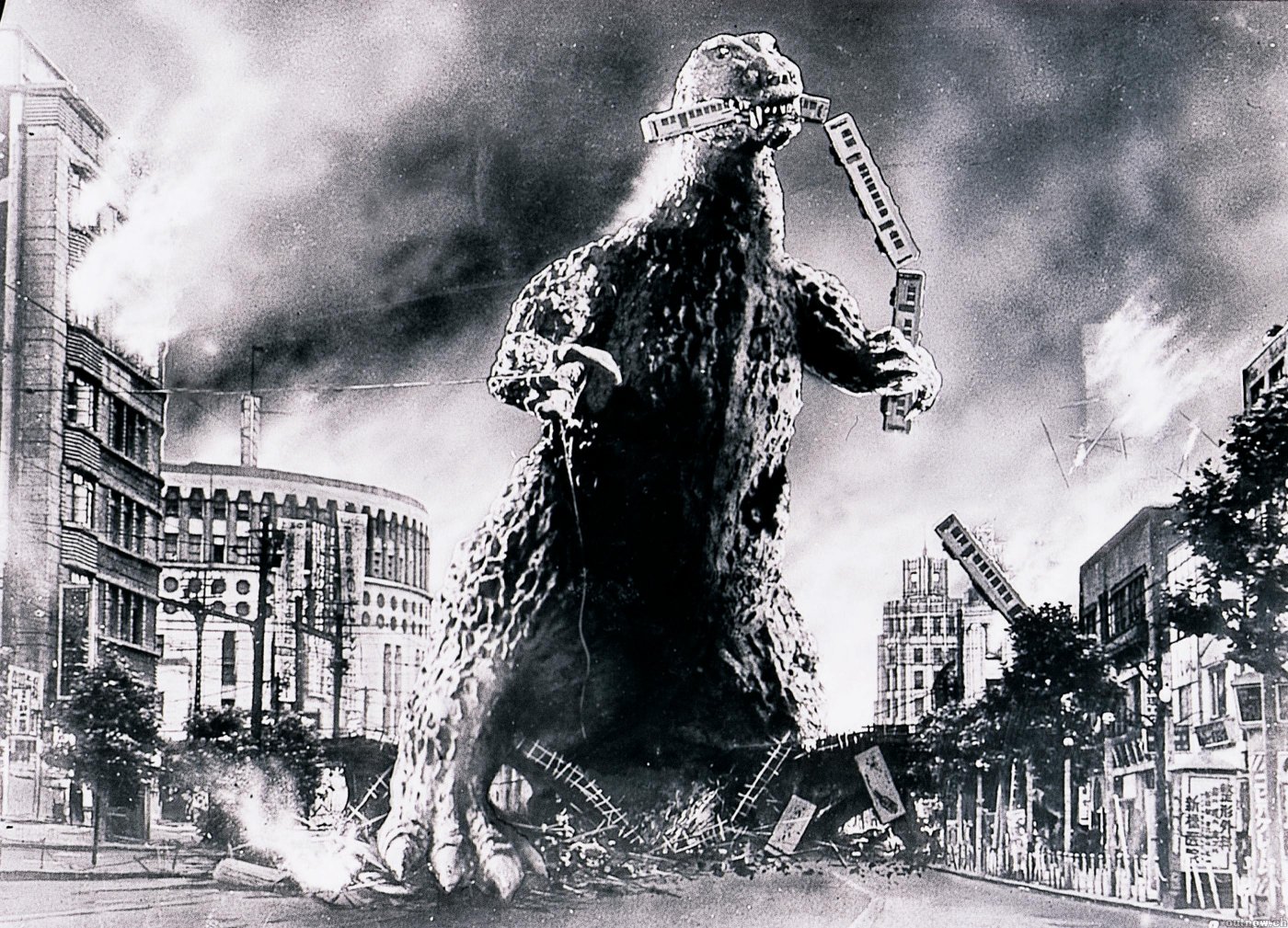everal Japanese merchant ships in the Pacific Ocean are mysteriously destroyed by a strange radioactive energy discharge that appears from beneath the water, killing most of the crew outright and causing the few survivors to later die of radiation sickness. An investigation on the nearby Odo Island reveals the culprit, which is apparently a hibernating dinosaur awakened by atomic bomb tests and mutated by the nuclear energy into a 50 meter tall, radiation spewing creature the natives call Godzilla, after a legendary sea monster from the island’s ancient folklore. Soon arriving in Tokyo, Godzilla destroys the entire city in a destructive rampage, easily defeating the military might of the Japanese Self Defense Force. Tokyo is left as an obliterated nuclear wasteland, with thousands of people left dead, injured, homeless or afflicted with radiation sickness.
Finally, an eccentric and embittered scientist named Dr. Daisuke Serizawa is convinced by his betrothed, Emiko, the daughter of the paleontologist Dr. Yamane, who is studying Godzilla, to use a weapon the scientist secretly created, called the Oxygen Destroyer, against the monster. Having already destroyed all of his notes, Dr. Serizawa successfully utilizes the Oxygen Destroyer to seemingly disintegrate Godzilla underwater, but not before committing suicide so as to prevent his terrible weapon from ever being used by the government in the same manner as the H-bomb.
Review/Comments:
The first G-film, with its deadly serious adult tone, horrific images of atomic devastation, and superior screenplay and direction, is often hailed as being second only to Akira Kurosawa’s The Seven Samurai as the greatest film to ever be produced in Japan. This is in marked contrast to the popular American misconception that all G-films were campy, child-oriented exploitation movies. Intended as a serious allegory of the atomic bombing of Hiroshima a mere nine years earlier, this film was atmospherically shot in black and white, and the scenes of human suffering and devastation of Tokyo are genuinely chilling and disturbing.
The character of Godzilla was the brainchild of the late Tomoyuki Tanaka, who acted as the producer or executive producer on the first 22 G-films over the course of 41 years, which encompassed not only the first G-film, but every single G-film to appear in both the Showa (“First Generation”) and Heisei (“Second Generation”) Era Godzilla film series (both named after the respective Japanese Emperor who presided over the nation’s political affairs during the era of time in the 20th century when the two respective Godzilla film series were produced and released). Tanaka conceived of the movie’s basic plot while contemplating new cinematic ideas for Toho as he relaxed during a flight home on an airplane. Upon his arrival in Japan, he quickly fleshed the character out completely during a consultation with the brilliant film director Ishiro Honda, who also ended up co-writing the screenplay to the first film.
The screenplay, co-written by Takeo Murata and Ishiro Honda, was excellent, adult in tone, and quite philosophically analytical, and the human direction by Honda was surpassingly well done, making this one of the best films of all time. The sfx by the late Eiji Tsuberaya were well executed, and most of it still holds up very well by today’s standards. Tsuberaya utilized the “suitmation” technique (i.e., a man in a monster costume amidst miniature models of a cityscape and military vehicles) in place of the fantastic stop motion animation techniques applied by the great Willis O’Brien in the original King Kong (1933), and later picked up on by O’Brien’s equally famous protégé, Ray Harryhausen, due to both budgetary restraints and a lack of expertise in this area by Tsuberaya. Although the stop motion animation technique was largely utilized in American cinema to realize gigantic creatures before CGI made this process completely obsolete by the 1990’s [the last movie to use the stop motion technique to simulate dai kaiju is, to my knowledge, either Troma’s campy B-fest Nymphoid Barbarian In Dinosaur Hell, or the equally campy but admittedly fun low-budget exploitation romp Dinosaur Island, both produced in the early 90’s], Toho didn’t start using CGI to depict their dai kaiju onscreen to any significant degree until the beginning of the Millennium Era (a.k.a., “Alternate Reality” G-series with Godzilla 2000 in 1999), and they have still largely retained the utilization of Tsuberaya’s suitmation process for a large portion of their monster scenes. Although the plot was admittedly taken from Harryhausen’s 1953 dai kajiu film The Beast From 20,000 Fathoms, the first G-film has far surpassed the considerable popularity of the latter film (much to Harryhausen’s alleged consternation).
Originally, Godzilla was conceived as a giant mutated octopus by Tsuberaya, but this was soon changed to the amphibious bipedal mutated dinosaur phenotype, since the latter type of creature would be much more capable of menacing human society on land. Some of the sfx was done differently than in later movies, such as Godzilla’s trademark atomic breath, which was realized here (as well as in the second G-film) by a smoky spray, rather than by animation, which was used from the 1960’s G-films onwards. Further, Akira Ifukube, the master maestro who is most identified with G-film soundtracks in the first two series, produced a unique and truly menacing score for the Big G, much different from all of his later musical numbers.

